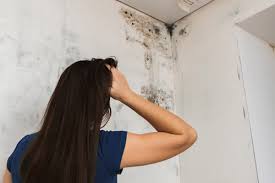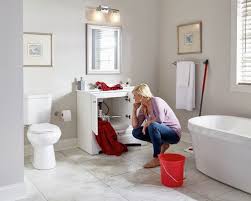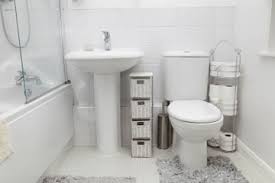Solved! What To Do About Black Mold in the Bathroom
What is black mold?
Stachybotrys chartarum, more commonly called black mold, is a serious problem. Though it may look similar to every other type of dark mold, there are some distinguishing features of black mold. The first is that black mold often has a slimy appearance. Black mold will also have a dark-green or slightly gray color to it.
Where does black mold grow?
Black mold often grows in places where there has been a water leak hidden from view. This could be a leak inside the walls, above ceiling, under floors or by windows, especially on the seal between the window and the frame. Since black mold needs a lot of moisture for a long time before it can grow, drying wet surfaces, reducing humidity and regular cleanings are suggested.
Health issues caused by black mold
The toxins released by this particular strain of mold are hazardous to a person’s health and can result in homeowners having to make serious repairs. The neurotoxins in black mold are called trichothecene mycotoxins and can cause things like confusion, dizziness, hallucinations, numbness and many more harmful side effects. When humans breath in the spores, they may experience any of these symptoms. Prolonged exposure to black mold spores may even lead to the development of asthma or other respiratory issues, bleeding in the lungs and nasal passages, swelling of the lungs and other serious issues. The list of health issues that black mold can cause is extensive and slightly frightening.

Preventing Mold
The best defense is preventing mold from occurring in the first place. offers the following tips for keeping mold out of your bathroom:
- Use your bathroom ventilation fan when you shower or bathe, and leave it on for 30 minutes following the end of your bath; if you don’t have an exhaust fan, install one.
- Keep household humidity levels below 50%; an air conditioner or dehumidifier can help.
- Use a mildew-resistant shower curtain, and wash or replace it frequently.
- Don’t keep bottles of shampoo or shower gel, toys, or loofahs in the shower, as they provide places for mold to grow and hide.
- Wash your bathroom rugs frequently.

Removing Mold From Painted or Wallpapered Walls
For mold on painted walls, try a natural remover like white vinegar, borax and water. You’ll need a spray bottle and a few other items to scrub the walls.
- Combine two tablespoons of borax with 1/4 cup white vinegar and two cups of hot water in a bowl.
- Pour into a spray bottle
- Liberally apply on painted walls.
- Scrub thoroughly and wipe clean, then spray again and let sit for 10 minutes before wiping dry.
Removing Mold Safely
You can scrub away the surface mold common to bathrooms, decks and siding in a matter of minutes with a 1-to-8 bleach/water mold cleaner solution as one way on how to remove mold. But often mold grows and spreads in places you don’t notice, until you spot surface staining, feel mushy drywall or detect that musty smell.
If you have to remove mold concentrations or perform any black mold removal covering more than a few square feet, where the musty odor is strong or where you find extensive water damage, we recommend that you take special precautions. You want to not only avoid contaminating the rest of the house but also protect yourself from breathing high concentrations of spores and VOCs.
- Wear old clothes and shoes that you can launder or throw away after the cleanup work.
- Wear special N-95 or P-100 respirators, in addition to goggles and gloves.
- Set an old box fan or a cheap new one in a window to ventilate the room while working. Throw it out when you’re done cleaning, because the spores are almost impossible to clean off. Tape plywood or cardboard around the window openings so the spores can’t blow back in.
- Wrap and tape moldy carpeting in 6-mil plastic, and double-bag mold-infested debris in garbage bags for disposal.
- To control airborne spores, moisten moldy areas with a garden sprayer while you work.
- Turn off your furnace and air conditioner and cover ducts and doors to contain spores.
- Keep your wet/dry vacuum outside when you vacuum.

What is the Best Way to Remove Black Mold in Your Bathroom?
If you’ve found black mold spores in your bathroom, you’ll want to perform removal immediately. If you have a huge problem, you need to bring in an expert to ensure that all the mold is removed properly.
If you find that you have a small amount of black spores on your shower, ceiling, bathtub, tile, and toilet, you can likely take care of it yourself. While you can use household cleaners to remove spores, if you want to get rid of it naturally use the following methods:
Tea tree oil
By mixing tea tree oil with water, you’ll be ale to spray the mixture onto the spores. Once the mixture has set for several hours, you should be able to scrub away the mold.If you finish the tea tree oil, complete the job using baking soda. Read about tea tree oil and fungal contamination.
Vinegar
Vinegar can be used straight from your bottle and sprayed on the affected area. You can finish the removal by adding in baking soda.
Hydrogen Peroxide
A teaspoon of hydrogen peroxide and water can be used to remove spores. It should stay on the moldy surface for 10 minutes. Wipe the surface off using baking soda and more hydrogen peroxide.
Prevent future mold growth.
- Keep vinegar on hand. Store a spray bottle of vinegar in the bathroom, and apply and air-dry after every shower or soak. (You might consider add several drops of your favorite essential oil—tea tree, peppermint, or lavender—to the bottle to make the vinegar’s smell less offensive.)
- Reduce the humidity. If you don’t have one, install an exhaust fan. Running one every time you shower or bathe and several minutes following should remove any residual steam and dry the air out.
- Wipe dry after every use. Squeegee and then towel down glass doors and tile to remove extra moisture from those surfaces. While you’re at it, wipe out sinks after each use, too, so that mold and mildew have nowhere to go (and grow).
- Clean regularly. Be sure to do a thorough cleaning of the bathroom weekly; if all else fails, this consistent regimen should keep mold spores from taking hold and running amok. Rotate an anti-fungal cleaner into the routine at least once a month.